
Messier 2 or M2 is a globular cluster in the constellation Aquarius, five degrees north of the star Beta Aquarii. It was discovered by Jean-Dominique Maraldi in 1746, and is one of the largest known globular clusters.

The Carina Nebula or Eta Carinae Nebula is a large, complex area of bright and dark nebulosity in the constellation Carina, located in the Carina–Sagittarius Arm of the Milky Way galaxy. The nebula is approximately 8,500 light-years (2,600 pc) from Earth.

Messier 39 or M39, also known as NGC 7092, is an open cluster of stars in the constellation of Cygnus, positioned two degrees to the south of the star Pi Cygni and around 9° east-northeast of Deneb. The cluster was discovered by Guillaume Le Gentil in 1749, then Charles Messier added it to his catalogue in 1764. When observed in a small telescope at low power the cluster shows around two dozen members but is best observed with binoculars. It has a total integrated magnitude (brightness) of 5.5 and spans an angular diameter of 29 arcminutes – about the size of the full Moon. It is centered about 1,010 light-years away.

Messier 48 or M48, also known as NGC 2548, is an open cluster of stars in the equatorial constellation of Hydra. It sits near Hydra's westernmost limit with Monoceros, about 18° 34′ to the east and slightly south of Hydra's brightest star, Alphard. This grouping was discovered by Charles Messier in 1771, but there is no cluster precisely where Messier indicated; he made an error, as he did with M47. The value that he gave for the right ascension matches, however, his declination is off by five degrees. Credit for discovery is sometimes given instead to Caroline Herschel in 1783. Her nephew John Herschel described it as, "a superb cluster which fills the whole field; stars of 9th and 10th to the 13th magnitude – and none below, but the whole ground of the sky on which it stands is singularly dotted over with infinitely minute points".
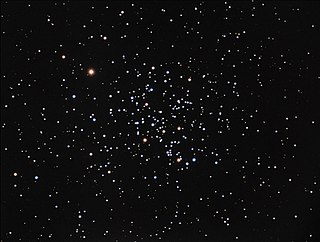
Messier 67 and sometimes called the King Cobra cluster or the Golden Eye cluster is an open cluster in the southern, equatorial half of Cancer. It was discovered by Johann Gottfried Koehler in 1779. Estimates of its age range between 3.2 and 5 billion years. Distance estimates are likewise varied, but typically are 800–900 parsecs (2,600–2,900 ly). Estimates of 855, 840, and 815 pc were established via binary star modelling and infrared color-magnitude diagram fitting.

Messier 93 or M93, also known as NGC 2447, is an open cluster in the modestly southern constellation Puppis, the imagined poop deck of the legendary Argo.
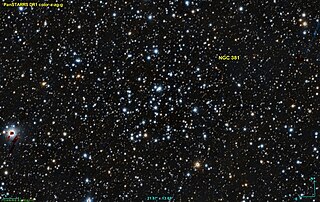
NGC 381 is an open cluster of stars in the northern constellation of Cassiopeia, located at a distance of approximately 3,120 light-years from the Sun. Credit for the discovery of this cluster was given to Caroline Herschel by her brother William in 1787, although she may never have actually seen it.

NGC 6231 is an open cluster in the southern sky located half a degrees north of Zeta Scorpii. NGC 6231 is part of a swath of young, bluish stars in the constellation Scorpius known as the Scorpius OB1 association. The star Zeta1 is a member of this association, while its brighter apparent partner, Zeta2, is only 150 ly from Earth and so is not a member.
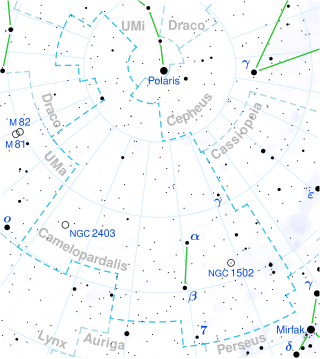
NGC 1502 is a young open cluster of approximately 60 stars in the constellation Camelopardalis, discovered by William Herschel on November 3, 1787. It has a visual magnitude of 6.0 and thus is dimly visible to the naked eye. This cluster is located at a distance of approximately 3,500 light years from the Sun, at the outer edge of the Cam OB1 association of co-moving stars, and is likely part of the Orion Arm. The asterism known as Kemble's Cascade appears to "flow" into NGC 1502, but this is just a chance alignment of stars.

NGC 3201 is a low galactic latitude globular cluster in the southern constellation of Vela. It has a very low central concentration of stars. This cluster was discovered by James Dunlop on May 28, 1826 and listed in his 1827 catalogue. He described it as "a pretty large pretty bright round nebula, 4′ or 5′ diameter, very gradually condensed towards the centre, easily resolved into stars; the figure is rather irregular, and the stars are considerably scattered on the south".
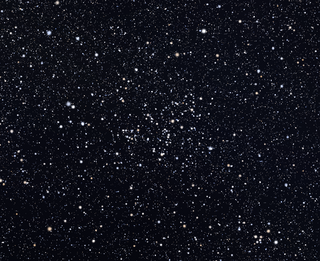
NGC 5822 is an open cluster of stars in the southern constellation of Lupus. It was discovered by English Astronomer John Herschel on July 3, 1836, and lies close to another cluster, NGC 5823, which suggests there may be a physical association.

NGC 6934 is a globular cluster of stars in the northern constellation of Delphinus, about 52 kilolight-years distant from the Sun. It was discovered by the German-born astronomer William Herschel on 24 September 1785. The cluster is following a highly eccentric orbit through the Milky Way along an orbital plane that is inclined by 73° to the galactic plane. It may share a common dynamic origin with NGC 5466. As of 2018, it has been poorly studied.
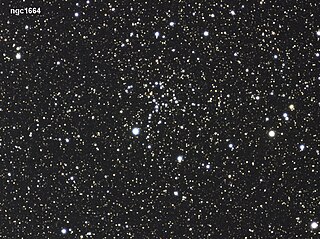
NGC 1664 is an open cluster in the constellation of Auriga. It contains stars with a total of around 640 solar masses with a tidal radius of 43 ly (13.2 pc).
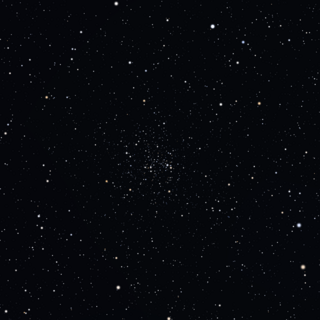
NGC 2506 is a mildly-elongated open cluster of stars in the equatorial constellation of Monoceros, located at a distance of 12.7 kly from the Sun near the Galactic anti-center. It was discovered by William Herschel in 1791. The cluster lies around 10,000 ly from the Galactic Center and about 1,600 ly above the Galactic plane. It is of intermediate age, estimated at around two billion years. The cluster has an angular radius of 12′ and a core radius of 4.8′.
Ruprecht 147 or NGC 6774 is a dispersed star cluster in the Milky Way galaxy. It is about 1,000 light years away, which is close to Earth in comparison with other such clusters. In late summer, it can be seen with binoculars in the constellation of Sagittarius. The stars, bound by gravity, are about 2.5 to 3.25 billion years old. The cluster, discovered in 1830 by John Herschel, was sometimes thought to be an asterism due to its sparseness and location against the background of the richest part of the Milky Way, and also since the brightest stars in this old cluster perished long ago. In 1966 the Czech astronomer Jaroslav Ruprecht classified it as a type III 2 m open cluster under the Trumpler scheme. It received otherwise little attention until 2012, when it was identified as a potentially important reference gauge for stellar and Galactic astrophysics research, particularly the research of Sun-like stars. Additionally, Ruprecht 147 has five detached eclipsing binary that are relatively bright, and thus easy to observe.

NGC 4993 is a lenticular galaxy located about 140 million light-years away in the constellation Hydra. It was discovered on 26 March 1789 by William Herschel and is a member of the NGC 4993 Group.

NGC 4103 is an open cluster in the constellation Crux. It was discovered by James Dunlop in 1826. It is located approximately 5,000 light years away from Earth, in the Carina-Sagittarius arm.
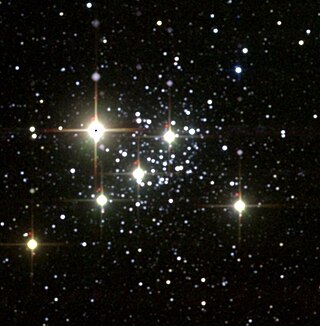
NGC 7419 is an open cluster in the constellation Cepheus. It is heavily reddened and notable for containing five red supergiants, the highest number known in any cluster until the end of the 20th century, but probably no blue supergiants.
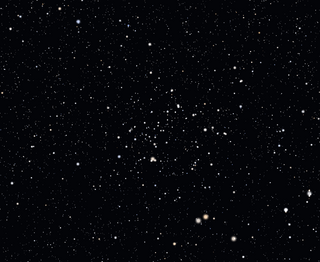
DS Andromedae is an eclipsing binary star in the constellation Andromeda and a member of the open cluster NGC 752. Its maximum apparent visual magnitude is 10.44, but drops down to 10.93 during the main eclipse and to 10.71 during the secondary one.
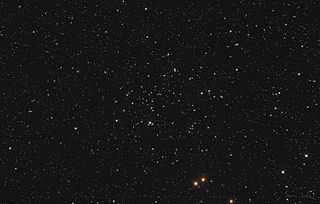
QX Andromedae is an eclipsing binary in the constellation Andromeda. It varies from a maximum apparent visual magnitude of 11.28 to a minimum of 11.50. Since it is impossible to specify the onset time of the eclipses, it is classified as a W Ursae Majoris variable star. It is also observed as an X-ray source and is a member of the open cluster NGC 752.





















